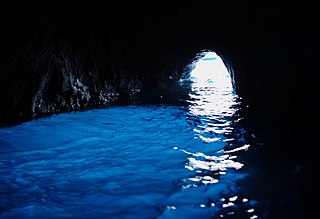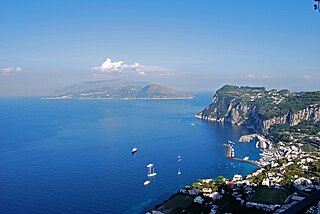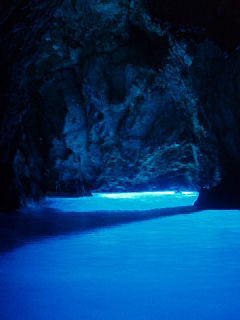
Ferdinand Gregorovius was a German historian who specialized in the medieval history of Rome.

Heligoland is a small archipelago in the North Sea. A part of the German state of Schleswig-Holstein since 1890, the islands were historically possessions of Denmark, then became the possessions of the United Kingdom from 1807 to 1890, and briefly managed as a war prize from 1945 to 1952.

Marcel Reich-Ranicki was a Polish-born German literary critic and member of the literary group Gruppe 47. He was regarded as one of the most influential contemporary literary critics in the field of German literature and has often been called Literaturpapst in Germany.

Capri is an island located in the Tyrrhenian Sea off the Sorrento Peninsula, on the south side of the Gulf of Naples in the Campania region of Italy. The main town Capri that is located on the island shares the name. It has been a resort since the time of the Roman Republic.

Föhrpronunciation (help·info) is one of the North Frisian Islands on the German coast of the North Sea. It is part of the Nordfriesland district in the federal state of Schleswig-Holstein. Föhr is the second-largest North Sea island of Germany and a popular destination for tourists. A town and eleven distinct municipalities are located on the island. The climate is oceanic with moderate winters and relatively cool summers.

Amrumpronunciation (help·info) is one of the North Frisian Islands on the German North Sea coast, south of Sylt and west of Föhr. It is part of the Nordfriesland district in the federal state of Schleswig-Holstein and has approximately 2,300 inhabitants.

The Blue Grotto is a sea cave on the coast of the island of Capri, southern Italy. Sunlight passing through an underwater cavity and shining through the seawater creates a blue reflection that illuminates the cavern. The cave extends some 50 metres into the cliff at the surface, and is about 150 metres (490 ft) deep, with a sandy bottom.

August Kopisch was a German poet and painter.

Anacapri is a comune on the island of Capri, in the Metropolitan City of Naples, Italy. The Ancient Greek prefix ana- means "up" or "above", signifying that Anacapri is located at a higher elevation on the island than Capri. Administratively, it has a separate status from the city of Capri. The most significant site in the village is the Villa San Michele.

Baron Jacques d'Adelswärd-Fersen was a French novelist and poet. His life forms the basis of a fictionalised biography by Roger Peyrefitte.

Uwe Timm is a German writer.
Blue Swords is an international figure skating competition organized by the Deutsche Eislauf-Union. It is usually held in Chemnitz, Saxony, Germany. Medals are awarded in the disciplines of men's singles, ladies' singles, pair skating, and ice dancing. Champions of the event win the "Blue Swords Trophy".
The island of Capri is situated in the Gulf of Naples, between the Italian Peninsula and the islands of Procida and Ischia. Made of limestone, its lowest part is at the center, while its sides are high and mostly surrounded by steep precipices, which contain numerous caves. Its topography is dominated by the slopes of the Monte Solaro in the West and Mont-Saint-Michel in the East.

The Blue Grotto or Blue Cave, is a waterlogged sea cave located in a small bay called Balun, on the east side of the island of Biševo and about 4.5 nautical miles (8.3 km) from Komiža, in the Croatian Adriatic. It is situated in the central Dalmatian archipelago, 5 km south-west of the island of Vis. The grotto is one of the best known natural beauty spots on the Adriatic and a popular show cave because of the glowing blue light that appears at certain times of day.

Paul Sarasin, full name Paul Benedict Sarasin was a Swiss naturalist and ethnologist. He is known as founder of National parks in Switzerland.

Hermann David Salomon Corrodi was an Italian painter of landscapes and orientalist scenes.
Georg Quedens is a German photographer and non-fiction writer as well as a local and natural historian.

Karl Lorenz Rettich was a German landscape artist and draftsman.

The Pair-non-Pair Cave is located near the village of Prignac-et-Marcamps, Aquitaine:Gironde (33) department in France. Only discovered in 1881 it is known for remarkable prehistoric parietal engravings - petroglyphic representations of wild animals, "which rank among the most ancient examples of art made by prehistoric" humans, dating back to between 30.000 and 25.000 BP, the Aurignacian cultural period of the Upper Paleolithic.
















